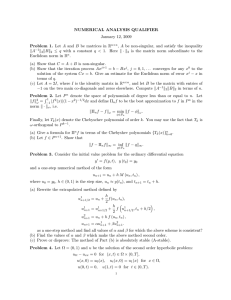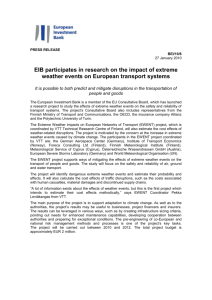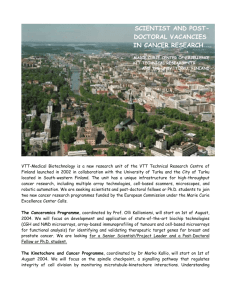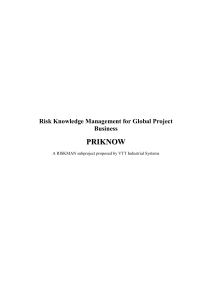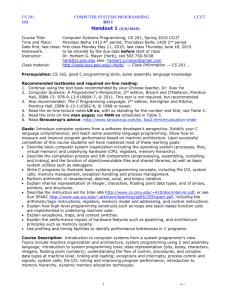GLOBAL SOLVABILITY OF A MIXED PROBLEM FOR A NONLINEAR HYPERBOLIC-PARABOLIC EQUATION
advertisement
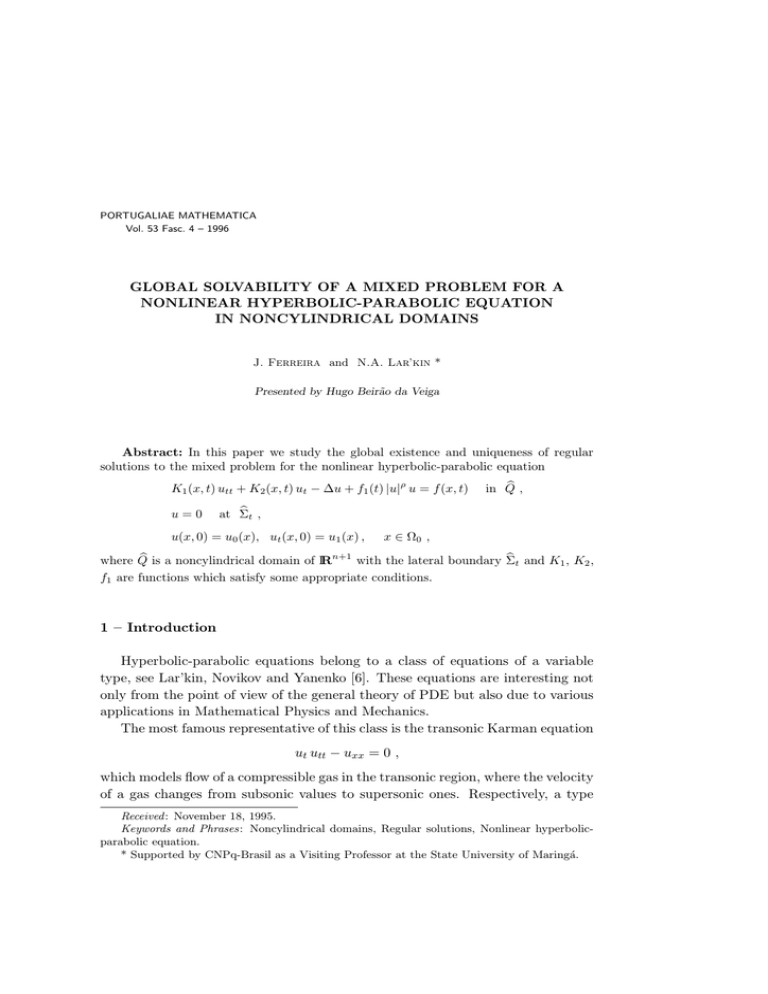
PORTUGALIAE MATHEMATICA
Vol. 53 Fasc. 4 – 1996
GLOBAL SOLVABILITY OF A MIXED PROBLEM FOR A
NONLINEAR HYPERBOLIC-PARABOLIC EQUATION
IN NONCYLINDRICAL DOMAINS
J. Ferreira and N.A. Lar’kin *
Presented by Hugo Beirão da Veiga
Abstract: In this paper we study the global existence and uniqueness of regular
solutions to the mixed problem for the nonlinear hyperbolic-parabolic equation
K1 (x, t) utt + K2 (x, t) ut − ∆u + f1 (t) |u|ρ u = f (x, t)
u=0
bt ,
at Σ
u(x, 0) = u0 (x), ut (x, 0) = u1 (x) ,
b,
in Q
x ∈ Ω0 ,
b is a noncylindrical domain of IRn+1 with the lateral boundary Σ
b t and K1 , K2 ,
where Q
f1 are functions which satisfy some appropriate conditions.
1 – Introduction
Hyperbolic-parabolic equations belong to a class of equations of a variable
type, see Lar’kin, Novikov and Yanenko [6]. These equations are interesting not
only from the point of view of the general theory of PDE but also due to various
applications in Mathematical Physics and Mechanics.
The most famous representative of this class is the transonic Karman equation
ut utt − uxx = 0 ,
which models flow of a compressible gas in the transonic region, where the velocity
of a gas changes from subsonic values to supersonic ones. Respectively, a type
Received : November 18, 1995.
Keywords and Phrases: Noncylindrical domains, Regular solutions, Nonlinear hyperbolicparabolic equation.
* Supported by CNPq-Brasil as a Visiting Professor at the State University of Maringá.
382
J. FERREIRA and N.A. LAR’KIN
of the Karman equation changes from elliptic to hyperbolic, depending on the
sign of ut . In the supersonic region, including the sonic curve, where ut = 0, the
Karman equation is hyperbolic-parabolic, and the variable t can be considered
as the time variable.
As a rulle, domains in which this equation is considered, are noncylindrical.
For example, flow of a gas in supersonic part of a Laval Nozzle which expands
with x, can be simulated by hyperbolic-parabolic equations in noncylindrical
domains.
A great number of papers dealt with hyperbolic-parabolic equations in cylindrical domains, but very few of them are devoted to regular solutions in noncylindrical domains. It seemed for us worthwhile to study this problem in the present
paper.
Let Ω be a bounded domain of IRn with a sufficiently smooth boundary Γ,
Q = Ω × (0, ∞), Σ = Γ × (0, ∞) and K ∈ C 4 (0, ∞).
Let us consider the subsets Ωt of IRn given by
n
o
Ωt = x ∈ IRn ; x = K(t) y, y ∈ Ω ,
0≤t≤T ≤∞,
b ∈ IRn+1 :
whose boundaries are denoted by Γt , and the noncylindrical domain Q
(1)
n
o
b = (x, t) ∈ IRn × (0, ∞); x ∈ Ωt =
Q
[
Ωt × {t}
0≤t<∞
with the lateral boundary
P
bt =
Σ
[
Γt × {t}
0≤t<∞
such that νt ≤ 0, K1 νt2 − ni=1 νx2i ≤ 0. Here νt , νxi are projections of an outer
b t on the corresponding axis. The noncylindrical domain Q
b
normal vector to Σ
defined by (1) is time like.
b we consider for the hyperbolic-parabolic equation the following mixed
In Q
problem:
K1 (x, t) utt + K2 (x, t) ut − ∆u + f1 (t) |u|ρ u = f (x, t)
(2)
u=0
bt ,
on Σ
u(x, 0) = u0 (x), ut (x, 0) = u1 (x) ,
b ,
in Q
x ∈ Ω0 ,
b
where f1 : [0, ∞) → IR, K1 (x, t) and K2 (x, t) are two real functions defined in Q,
Pn
∂2
∆ = i=1 ∂x2 .
i
383
NONCYLINDRICAL DOMAINS
Linear and nonlinear wave equations in noncylindrical domains have been
treated by many authors. Lions [9] introduced the penalty method to solve the
existence problem. Using this method, Medeiros [10] proved the existence of weak
solutions to the problem
(3)
utt − ∆u + β(u) = f
for a wide class of β(u) such that β(u) u ≥ 0. Cooper and Bardos [1] proved
the existence and uniqueness of weak solutions of (3), for the case β(u) = |u| α u
b t is globally “time like”, without the increasing condition on
(α ≥ 0) and when Σ
b
Q. Cooper and Medeiros [2] included the above results in a general model
utt − ∆u + f (u) = 0 ,
b t is globally “time like”. Inoue [4] sucwhere f is continuous, sf (s) ≥ 0 and Σ
ceeded in proving the existence of classical solutions to (3) for the case n = 3 and
β(u) = u3 when the body is “time like” at each point.
Ferreira [3] studied the existence of weak solutions to the mixed problem for
the equation
K1 (x) utt + K2 (x) ut + A(t) u + H(u) = f ,
K1 ≥ 0 .
Da Prato and Grisvard [11] established existence, uniqueness and regularity
results in our type of noncylindrical domains Q̂ for the following problem
utt − ∆u − ρ ∆ut = 0
(4)
u + ρ ut = 0
b ,
in Q
at Γt , 0 < t < T ,
u(x, 0) = u0 (x), ut (x, 0) = u1 (x) ,
x ∈ Ω0 .
Some paper dealt also with regular solutions in nondegenerate case [4, 11]. Degenerating of nonlinear hyperbolic equations brings essential difficulties in a case
of noncylindrical domains, because a geometry of a domain influences correctness
of problem (2). See Lar’kin [5], when a domain is characteristic.
The goal of this paper is to prove existence and uniqueness of regular solutions
to problem (2) for all t ∈ [0, ∞) in noncylindrical domains (1).
Our approach consists of changing of variables, v(y, t) = u(K(t)y, t). Under
b is formulated in the cylindrical domain
this transformation problem (2) in Q
Q = Ω × [0, ∞) as follows:
K3 (y, t) vtt + K4 (y, t) vt −
n
X
i,j=1
µ
∂
∂v
aij (y, t)
∂yi
∂yj
¶
+
384
+
J. FERREIRA and N.A. LAR’KIN
n
X
i=1
bi (y, t)
n
∂vt X
∂v
ci (y, t)
+
+ f1 (t) |v(y, t)|ρ v(y, t) = g(y, t)
∂yi i=1
∂yi
v=0
on Σ = Γ × [0, ∞) ,
v(0) = v0 (y) = u0 (K(0)y) ,
(5)
in Q ,
vt (0) = u1 (K(0)y) +
y∈Ω,
n
∂v0
K 0 (0) X
yi
= v1 (y) ,
K(0) i=1 ∂yi
y∈Ω,
where
K1 (x, t) = K1 (K(t)y, t) ≡ K3 (y, t) ,
K2 (x, t) = K2 (K(t)y, t) ≡ K4 (y, t) ,
(6)
f (x, t) = f (K(t)y, t) ≡ g(y, t) ,
and
0
aij (y, t) = (δij − K 2 K3 yi yj ) K −2 ,
bi (y, t) = −2K3 K 0 K −1 yi ,
h
0
ci (y, t) = (1 − n) K 2 K3 − K
0
− K 2 K −2
n
X
yi yj
j=1
00 2
i
K3 K − K 0 K K4 K −2 yi
∂K3
.
∂yj
The paper is organized as follows:
2 – Notations and assumptions.
3 – Existence of regular solutions.
4 – Uniqueness.
5 – Proof of Theorem 3.1.
2 – Notations and assumptions
By D(Ω) we denote the space of infinitely differentiable functions with a
compact support contained in Ω. The inner products and norms in L2 (Ω) and
H01 (Ω) will be represented by (·, ·)(t), | · |(t), ((·, ·))(t), k · k(t) respectively. By
H −1 (Ω) we denote the dual space of H01 (Ω). If X is a Banach space, then we
385
NONCYLINDRICAL DOMAINS
denote by Lp (0, ∞; X), 1 ≤ p ≤ ∞ the Banach space of vector valued functions
u : [0, ∞) → X, which are measurable and ku(t)kX ∈ Lp (0, ∞), with the norms:
kukLp (0,∞;X) =
hZ
∞
0
ku(t)kpX dt
i1/p
1≤p<∞,
,
kukL∞ (0,∞;X) = ess sup ku(t)kX .
0≤t<∞
We define Lq (0, ∞; Lp (Ωt )), the space of functions w ∈ Lq (0, ∞; Lp (IRn )),
such that w = 0 in IRn \Ωt
kwkLq (0,∞;Lp (Ωt )) =
and
hZ
∞
0
kw(t)kqLp (Ωt ) dt
i1/q
kwkL∞ (0,∞;Lp (Ωt )) = ess sup kw(t)kLp (Ωt ) .
0≤t<∞
If w ∈ Lp (Ωt ) ∩ H01 (Ωt ), we continue it by 0 in IRn \Ωt . Then we observe
that Lq (0, ∞; Lp (Ωt )) is a closed subspace of Lq (0, ∞; Lp (IRn )) for 1 ≤ q ≤ ∞.
In the same way we define Lq (0, ∞; H01 (Ωt )) as the space of functions w ∈
Lq (0, ∞; H 1 (IRn )) such that w = 0 in IRn \Ωt with the norm
kwkLq (0,∞;H 1 (Ωt )) =
0
hZ
∞
0
kw(t)kqH 1 (Ωt ) dt
0
i1/q
for 1 ≤ q < ∞, and
kwkL∞ (0,∞;H 1 (Ωt )) = ess sup kw(t)kH 1 (Ωt ) .
0
0
0≤t<∞
Let us consider the following family of operatos in L(H01 (Ω), H −1 (Ω))
A(t) = −
n
X
i,j=1
where
(7)
aij = aji
µ
¶
∂
∂
,
aij (y, t)
∂yi
∂y
and
aij ∈ W 3,∞ (0, ∞; C 0 (Ω))
for all i, j = 1, ..., n.
We suppose that
(8)
n
X
i,j=1
where α is a positive constant.
t≥0,
aij (y, t) ξi ξj ≥ α |ξ|2 ,
386
J. FERREIRA and N.A. LAR’KIN
For u, v ∈ H01 (Ω) we denote a(t, u, v):
a(t, u, v) =
n Z
X
i,j=1 Ω
∂u ∂v
dy .
∂yi ∂yj
aij (y, t)
From the hypothesis on aij , we obtain that a(t, u, v) is symmetric and
a(t, u, u) ≥ αkuk2 for all u ∈ H01 (Ω) ,
(9)
t ∈ [0, ∞) .
Suppose that functions K1 , K2 , K, f1 , ρ satisfy the following conditions:
A.1:
K1 (x, t) ≥ 0
b ,
in Q
K1 (x, 0) ≥ η0 > 0
in Ω0 ,
K1 ∈ W 3,∞ (0, ∞; C 0 (Ωt )) ,
K2 ∈ W 1,∞ (0, ∞; C 0 (Ωt )) ,
µ(x, t) = K2 (x, t) −
¯
¯
¯ ∂K1 ¯
¯
¯
¯ ∂x ¯ ≤ CK1 + η ,
1
|K1t (x, t)| ≥ δ0 > 0
2
b ,
in Q
i = 1, ..., n ,
i
where η is a sufficiently small positive number.
A.2:
K ∈ C 4 (0, ∞) ,
min K(t) = α0 > 0 ,
0≤t<∞
sup K 0 (t) = γ <
0≤t<∞
max K(t) = α1 > 0 ,
0≤t<∞
1
,
M
M = sup{|y|, y ∈ Ω} ,
IRn
K 0 (t) ≥ 0, |K 00 (t)|, |K 000 (t)|, |K (iv) (t)| ≤ C ,
m1 =
m3 =
m5 =
m7 =
Z
Z
Z
Z
∞
K 0 (t) dt < ∞ ,
0
∞
000
|K (t)| dt < ∞ ,
0
∞
(K 0 (t))2 dt < ∞ ,
0
∞
0
(K 0 (t))3 dt < ∞ ,
m2 =
Z
∞
0
m4 =
m6 =
m8 =
Z
∀ t ∈ [0, ∞) ,
|K 00 (t)| dt < ∞ ,
∞
|K (iv) (t)| dt < ∞ ,
0
Z
Z
∞
(K 00 (t))2 dt < ∞ ,
0
∞
0
|K 00 (t)|3 dt < ∞ .
NONCYLINDRICAL DOMAINS
387
A.3:
{f1 , f10 } ∈ (L1 (0, ∞) ∩ L∞ (0, ∞))2 ,
f10 (t) ≤ 0 ,
∀ t ∈ [0, ∞) ,
f1 (t) ≥ 0 ,
∀ t ∈ [0, ∞) ,
0<ρ≤
2
if n > 2
n−2
and
0 < ρ < ∞ if n = 1 or n = 2 .
3 – Existence of regular solutions
Theorem 3.1. Let u0 ∈ H02 (Ω0 ), u1 ∈ H01 (Ω0 ) and f ∈ H 1 (0, ∞; L2 (Ωt )).
Assume that A.1–A.3 take a place. Then there exists a unique function u(x, t)
b such that
defined in Q
u ∈ L∞ (0, ∞; H01 (Ωt ) ∩ H 2 (Ωt )) ,
ut ∈ L∞ (0, ∞; H 1 (Ωt )) ,
(10)
K1 utt ∈ L∞ (0, ∞; L2 (Ωt )) ;
b ,
utt ∈ L2 (Q)
for a.e. t ∈ (0, ∞) the identity holds
(11)
³n
o
´
K1 utt + K2 ut − ∆u + f1 (t) |u|ρ u , w (t) = (f, w)(t) ,
where w is an arbitrary function from L2 (IRn ),
u(0) = u0 ,
(12)
ut (0) = u1 ,
u=0
on Σ̂t .
Remark 3.1. Here and in the sequel we use notations of [8].
Proof of Theorem 3.1 will be given in section 5. At first we will study our
problem in a cylinder Q.
b are related by the diffeomorphism h : Q
b → Q defined by
Domains Q and Q
h(x, t) =
µ
x
,t
K(t)
¶
b ,
for (x, t) ∈ Q
388
J. FERREIRA and N.A. LAR’KIN
b defined by
and h−1 : Q → Q
(13)
h(y, t) = (K(t)y, t) .
b v(y, t) = u(K(t)y, t).
For each u ∈ L2 (Q);
By change of variables x = K(t)y, we obtain v ∈ L2 (Q).
Taking into account A.1–A.2, it is easy to verify that
B.1:
K3 (y, t) ≥ 0
in Q ,
K3 (y, 0) ≥ η0 > 0
in Ω ,
K3 ∈ W 3,∞ (0, ∞; C 0 (Ω)) ,
K4 ∈ W 1,∞ (0, ∞; C 0 (Ω)) ,
¯
¯
n
∂K3 ¯¯
1 ¯¯ 0 K 0 (t) X
≥ δ0 > 0
yi
r(y, t) = K4 − ¯K3 −
2
K(t) i=1
∂yi ¯
¯
¯
¯ ∂K3 ¯
¯
¯
¯ ∂y ¯ ≤ CK3 + η ,
in Q ,
η is a sufficiently small positive number .
i
B.2:
aij = aji
and
aij ∈ W 3,∞ (0, ∞; C 0 (Ω)) ,
a(t, v, v) ≥ α kvk2H 1 (Ω) in Q
(α > 0) .
0
Let f , u0 , u1 be as in 3.1. By (13) we obtain
(14)
v0 ∈ H02 (Ω) ,
v1 ∈ H01 (Ω) .
Theorem 3.2. Under conditions of Theorem 3.1, for any f ∈ H 1 (0, ∞; L2 (Ω))
there exists a unique function v(y, t) satisfying initial data (4),
v ∈ L∞ (0, ∞; H01 (Ω) ∩ H 2 (Ω)) ,
(15)
vt ∈ L∞ (0, ∞; H01 (Ω)) ,
K3 vtt ∈ L∞ (0, ∞; L2 (Ω)) ;
vtt ∈ L2 (Q) ,
389
NONCYLINDRICAL DOMAINS
for a.e. t ∈ (0, ∞) the identity holds
(16)
Ã(
K3 vtt + K4 vt −
µ
n
X
∂
∂v
aij (y, t)
∂yi
∂yj
i,j=1
¶
+
n
X
bi
i=1
∂vt
+
∂yi
)
n
X
!
∂v
ci
+
+ f1 (t) |v|ρ v , w (t) = (g, w)(t) .
∂y
i
i=1
Here w is an arbitrary function from L2 (Ω).
Proof:
problem
For small ε > 0 we consider in a cylinder Q the following mixed
ε
K3ε vtt
+ K4 vtε −
n
X
µ
∂v ε
∂
aij (y, t)
∂yi
∂yj
i,j=1
n
X
+
ci (y, t)
i=1
(17)
vε = 0
∂v ε
∂yi
¶
+
n
X
bi (y, t)
i=1
∂vtε
+
∂yi
+ f1 (t) |v ε |ρ v ε = g(y, t)
in Q ,
on Σ = Γ × [0, ∞) ,
v ε (y, 0) = v0 (0) = u0 (K(0)y) ,
vtε (y, 0) = u1 (K(0)y) +
y∈Ω,
n
K 0 (0) X
∂v0
= v1 (y) ,
yi
K(0) i=1 ∂yi
y∈Ω,
where K3ε = K3 + ε.
Let (wν )ν∈IN be a basis in H02 (Ω). For each m ∈ IN we define
um,ε (y, t) =
m
X
g`mε (t) w` (y) ,
`=1
where unknown functions g`mε (t) are solutions to the following Cauchy problem
for the system of ordinary differential equations
m,ε
(K3ε vtt
, w` ) + (K4 vtm,ε , w` ) + a(t, v m,ε , w` ) −
−2
(18)
¶ X
¶
n µ
n µ
∂v m,ε
∂v m,ε
K 0 (t) X
K 3 yi t , w ` +
ci (t)
, w` +
K(t) i=1
∂yi
∂yi
i=1
³
´
+ f1 (t) |v m,ε |ρ v m,ε , w` = (g, w` ) ,
g`mε (0) = (v0 , w` ) ,
0
g`mε
(0) = (v1 , w` ) .
1≤`≤m,
390
J. FERREIRA and N.A. LAR’KIN
This problem has solutions g`mε ∈ C 2 ([0, Tmε )), 0 < Tmε < T . The a priori
estimates, we shall obtain, will permit us to extend the approximate solutions
v m,ε to the interval [0, ∞) and also pass to the limit as m → ∞, ε → 0.
A PRIORI ESTIMATE 1. In our calculations we wil omit indices m, ε. Multiplying (18) by 2g`t , summing over `, using the hypothesis B.1–B.2 and A.3, we
find
¸
·
d p
2
(19)
| K3ε vt | (t) + a(t, v(t), v(t)) + (f1 (t), M (u)) +
dt
µ
¶
n
∂k3
K 0 (t) X
yi
+ 2K4 − K30 +
, |vt |2 − (f10 (t), M (u)) −
K(t) i=1 ∂yi
¶
n µ
∂vt
K 0 (t) X
, K 3 yi v t +
− a (t, v(t), v(t)) − 4
K(t) i=1 ∂yi
0
+2
Ru
n µ
X
i=1
|s|ρ s ds
¶
∂v
, vt = 2 (g(t), vt ) ,
ci (t)
∂yi
where M (u) = 0
≥ 0.
Integrating (19) from 0 to t, using the hypothesis B.1–B.2, A.2–A.3, and
observing that K3ε vt2 ≥ K3 vt2 ≥ 0, we obtain
(20)
p
| K3 vt |2 (t) + αkvk2H 1 (Ω) ≤
≤C+
Z
t
0
0
³p
0
where f2 (t) ∈ L1 (0, ∞). Hence, by Gronwall’s Lemma
p
(21)
´
f2 (τ ) | K3 vτ |2 (τ ) + kvk2H 1 (Ω) (τ ) dτ +
2
| K3 vt | (t) +
αkvk2H 1 (Ω)
0
+ δ0
Z
t
0
Z
t
|g|2 (τ ) dτ ,
0
|vτ |2 (τ ) dτ ≤ C ,
where C is a positive constant independent of m and t ∈ [0, ∞).
A PRIORI ESTIMATE 2. Now we differentiate equation (17) with respect to
t, multiply the result by 2g`tt and summ over ` to obtain
i
dhp
(22)
| K3ε vtt |2 (t) + a(t, vt (t), vt (t)) + 2 a0 (t, v(t), vt (t)) +
dt
¶
¶¶
µ µ
µ
n
∂K3
K 0 (t) X
1
2
0
yi
, |vtt | + 2(K40 vt , vtt ) −
+ 2 K4 +
K3 −
2
K(t) i=1
∂yi
00
0
− 2a (t, v(t), vt (t)) − 3a (t, vt (t), vt (t)) + 2
+2
n µµ
X
i=1
¶
¶
n µµ
X
i=1
∂vt
bi
∂yi
¶0
¶
, vtt +
∂v 0
, vtt + 2((f1 (t)|v|ρ v)0 , vtt ) = 2(g 0 , vtt ) .
ci
∂yi
391
NONCYLINDRICAL DOMAINS
Integrating (22) from 0 to t, using the hypothesis A.2–A.3 and B.1–B.2 and
2 ≥ K v 2 ≥ 0, we have
observing that K3ε vtt
3 tt
(23)
p
2
2
| K3 vtt | (t) + αkvt k + δ0
≤ C1 +|(K3 vtt (0), vtt (0))|+
Z
t
0
Z
t
0
|vτ τ (τ )|2 dτ ≤
hp
2
f2 (τ ) | K3 vτ τ | (τ )+kvτ (τ )k
2
i
dτ +
Z
t
0
|gτ (τ )|2 dτ .
Remark 3.2. We need an estimate for vtt (0). Putting t = 0 in (17) and
using hypothesis about the function K3 , we obtain |vtt (0)| ≤ C, where a constant
C does not depend on m, t ∈ [0, ∞).
Now, using Remark 3.2, observing that f2 (t) ∈ L1 (0, ∞), by Gronwall’s
Lemma we get
(24)
p
2
| K3 vtt | (t) +
αkvk2H 1 (Ω)
0
δ0
+
4
Z
t
0
|vτ τ (τ )|2 dτ ≤ C ,
where C is a positive constant independent of m and t ∈ [0, ∞).
Let us now study the nonlinear term.
Since f1 (t) ∈ L1 (0, ∞) ∩ L∞ (0, ∞), we have from (21) and (24)
°
°
°
°
°f1 (t) |v m,ε |ρ+1 °
(25)
L2 (0,∞;L2 (Ω))
≤C .
By compactness arguments
(26)
f1 (t) |v m,ε |ρ v m,ε → f1 (t) |v ε |ρ v ε a.e. in Q ,
m→∞.
From (25), (26) we conclude:
(27)
f1 (t) |v m,ε |ρ v m,ε → f1 (t) |v ε |ρ v ε
weakly in L2 (Q) .
From the a priori estimates obtained we can see that there exists a subsequence
of (v m,ε ), which we still denote by (v m,ε )m∈IN , such that
v m,ε → v ε
weak∗ in L∞ (0, ∞; H01 (Ω)) ,
vtm,ε → vtε
weak∗ in L∞ (0, ∞; H01 (Ω)) ,
m,ε
ε
vtt
→ vtt
weakly in L2 (Q) ,
m,ε
ε
K3ε vtt
→ K3ε vtt
weak∗ in L∞ (0, ∞; L2 (Ω)) ,
f1 (t) |v m,ε |ρ v m,ε → f1 (t) |v ε |ρ v ε
weakly in L2 (Q) .
392
J. FERREIRA and N.A. LAR’KIN
Letting m tend to ∞, we conclude
ε
(K3ε vtt
,
w)(t) +
(K4 vtε , w)(t)
µX
n
µ
µX
n
¶
¶
∂
∂v ε
aij (y, t)
, w (t) +
+
∂yi
∂yj
i,j=1
¶
µX
¶
n
³
´
∂vtε
∂v ε
bi
ei
+
, w (t) +
, w (t) + f1 (t) |v ε |ρ v ε , w (t) =
∂yi
∂yi
i=1
i=1
= (g, w)(t)
for a.e. t ∈ (0, ∞) ,
where w is an arbitrary function from H01 (Ω).
Obviously, initial conditions (17) are satisfied. Observe that estimates obtained are also independent of ε. Therefore, by the same argument we can pass
to the limit when ε goes to zero in {v ε }. Thus we obtain a function
v ∈ L∞ (0, ∞; H01 (Ω)) ,
vt ∈ L∞ (0, ∞; H01 (Ω)) ,
vtt ∈ L2 (Q) ,
K3 vtt ∈ L∞ (0, ∞; L2 (Ω)) ,
satisfying the identity
µ
n µ
X
∂
i,j=1
=
ý
g − K3 vtt − K4 vt −
≡ (P (y, t), Z)(t)
∂yi
n ·
X
i=1
¶
¶
∂v
aij
, Z (t) =
∂yj
¸
¾
!
∂vt
∂v
bi
+ ci
− f1 (t) |v|ρ v , Z (t) ≡
∂yi
∂yi
for a.e. t ∈ (0, ∞) ,
where Z is an arbitrary function from H01 (Ω) and P ∈ L2 (Ω).
It follows from the properties of a function v(y,t) that P (y,t) ∈ L∞ (0,∞;L2 (Ω)).
The theory of elliptic equations gives us
v ∈ L∞ (0, ∞; H01 (Ω) ∩ H 2 (Ω)) .
This completes the existence part of Theorem 3.2.
393
NONCYLINDRICAL DOMAINS
4 – Uniqueness
Let v1 , v2 be two distinct solutions to (16). Putting w = 2(v1 −v2 ), we obtain:
i
dhp
| K3 wt |2 (t) + a(t, w(t), w(t)) +
dt
+ (2K4 − K1t , wt2 ) − a0 (t, w(t), w(t)) + 2
+2
(28)
µX
n
ci
i=1
w=0
µX
n
bi
i=1
¶
³
¶
∂wt
, wt +
∂yi
´
∂w
, wt + 2 f1 (t) |v1 |ρ v1 − f1 (t) |v2 |ρ v2 , wt = 0 ,
∂yi
on Σ ,
w(0) = 0 ,
wt (0) = 0 .
Green’s formula gives
2
n µ
X
i=1
¶
µ
n
X
∂bi
∂wt
, wt = −
, wt2
bi
∂yi
∂y
i
i=1
¶
and
(29)
−
n µ
X
∂bi
i=1
∂yi
¶
, wt2 =
n ³
X
´
2K3 K 0 K −1 , wt2 + 2
i=1
¶
n µ
K 0 (t) X
∂K3
, wt2 .
yi
K(t) i=1
∂yi
With regard to the nonlinear term, we obtain
(30)
¯³
¯
´¯
¯
2 ¯ f1 (t) |v1 |ρ v1 − f1 (t) |v2 |ρ v2 , wt ¯ ≤
≤ 2 f1 (t)
Z ¯³
´¯
¯
¯
¯ |v1 |ρ v1 − |v2 |ρ , wt ¯ dy
Ω
≤ 2 f1 (t) Cρ
Z h
Ω
i
|v1 (t)|ρ + |v2 (t)|ρ |w(t)| |wt (t)| dy .
Since injection H01 (Ω) ,→ Lq (Ω) is continuous, if
then |u|ρLp , |v|ρLρ ∈ Ln (Ω). From (30) we find
(31)
¯³
¯
´¯
¯
1
n
+
1
2
+
1
q
= 1 and ρ n ≤ q,
2 ¯ f1 (t) |v1 |ρ v1 − f2 (t) |v2 |ρ v2 , wt ¯ ≤ Cρ f1 (t) kwk |wt | .
Integrating (28) from 0 to t < ∞, using the hypothesis A.2–A.3, B.1–B.2,
(28), (29), (31) and the inequality of Schwartz, we have
394
J. FERREIRA and N.A. LAR’KIN
p
| K3 wt |2 (t) + α
+
Z
|∇w|2 (t) dy +
Ω
Z tµ
0
¶
n
∂K3
1 0 K 0 (τ ) X
yi
2 K 4 − K3 +
|wτ |2 (τ ) dτ +
2
K(τ ) i=1
∂yi
+
≤ Cε
Z
t
0
p
2
f2 (τ ) | K3 wτ | (τ ) dτ + Cε
Z
Z tZ
0
t
0
Ω
2n K3 K 0 K −1 |wτ |2 (τ ) dy dτ ≤
2
f2 (τ ) |∇w| (τ ) dτ + ε
Z
t
0
|wτ |2 (τ ) dτ .
From here
p
| K3 wt |2 (t) + α
Z
|∇w|2 (t) dy ≤ C
Ω
Z
t
0
³
p
´
f3 (τ ) |∇w|2 (τ ) + | K3 wτ |2 (τ ) dτ ,
where f3 (t) = max{f1 (t), f2 (t)}, ∀ t ∈ [0, ∞).
Since f3 (t) ∈ L1 (0, ∞), we have by Gronwall’s lemma ∇w(t) ≡ 0 a.e. t ∈
[0, ∞). With w|Σ = 0 we conclude that w(t) ≡ 0 in Q, hence v1 = v2 . The proof
of Theorem 3.2 is completed.
5 – Proof of Theorem 3.1
Let v be the solution from Theorem 3.2 and u defined by (13). Then
b
u ∈ L∞ (0, ∞; H01 (Ωt ) ∩ H 2 (Ωt )); ut ∈ L∞ (0, ∞; H 1 (Ωt )), utt ∈ L2 (Q);
∞
2
K1 utt ∈ L (0, ∞; L (Ωt )), u(0) = u0 and ut (0) = u1 .
If w ∈ L2 (0, ∞; H01 (Ωt )), let φ(y, t) = w(K(t)y, t) for (y, t) ∈ Q. We note that
(16) is valid. Changing the variable x = K(t) y, we obtain (11) from (16).
Let u1 , u2 be two solutions to (11), and v1 , v2 be the functions obtained
through the isomorphism h. Then v1 , v2 are the solutions to (16).
By the uniqueness result of Theorem 3.2, we have v1 = v2 , so u1 = u2 .
Thus the proof of Theorem 3.1 is completed.
Remark 5.1.
general equations
Results of Theorem 3.1 can be easily generalized for more
K1 (x, t) utt + K2 (x, t) ut + A(t) u + f1 (t) H(u) = f ,
where A(t) is a strictly elliptic operator and a smooth function H(u) satisfies the
condition H(u) u ≥ 0.
NONCYLINDRICAL DOMAINS
395
REFERENCES
[1] Cooper, J. and Bardos, C. – A nonlinear wave equation in a time dependent
domain, J. Math. Anal. Appl., 42 (1973), 29–60.
[2] Cooper, J. and Medeiros, L.A. – The Cauchy problem for nonlinear wave
equations in domain with moving boundary, Annali dela Scuola Normale Superiore
di Pisa, XXVI (1972), 829–838.
[3] Ferreira, J. – Nonlinear hyperbolic-parabolic partial differential equation in
noncylindrical domain, Rendiconti del Circolo Matemático di Palermo, 44 (1995),
135–146.
[4] Inoue, A. – Sur t
u u + u3 = f dans un domaine non cylindrique, J. Math. Anal.
Appl., 46 (1974), 777–819.
[5] Lar’kin, N.A. – Global solvability of boundary value problems. For a class of
quasilinear hyperbolic equations, Siberian Math. J., 1 (1981), 82–88.
[6] Lar’kin, N.A., Novikov, V.A. and Yanenko, N.N. – Towards a theory of
variable-type equations, in: “Numerical Methods in Fluid Dynamics” (N.N. Yanenko and Yu.I. Shokiu, Eds.), Moscow, Mir, 1984, 315–335.
[7] Lions, J.L. – Une remarque sur les problèmes d’évolution nonlinéaires dans les
domaines non cylindriques, Rev. Romaine Pures Appl. Math., 9 (1964), 11–18.
[8] Lions, J.L. and Magenes, E. – Non-Homogeneous Boundary Value Problems
and Applications, Springer-Verlag, Berlin–Heidelberg–New York, 1972.
[9] Lions, J.L. – Quelques Méthodes de Résolution des Problèmes aux Limites Non
Linéaires, Dunod, Paris, 1969.
[10] Medeiros, L.A. – Non-linear wave equations in domains with variable boundary,
Arch. Rational Mech. Anal., 47 (1972), 47–58.
[11] Da Prato, G. and Grisvard, P. – The damped wave equation in a noncylindrical domain, Diff. Int. Eqs., 7 (1994), 735–746.
[12] Sidelnik, Y.I. – Existence and uniqueness of a generalized solution of the mixed
problem for an equation of plate oscillation type in a noncylindrical domains, J. of
Soviet. Math., 63 (1993), 98–101.
Jorge Ferreira,
Departamento de Matemática, Universidade Estadual de Maringá,
87020-900, Maringá - PR – BRASIL
and
Nickolai A. Lar’kin,
The Institute of Theoretical and Applied Mechanics,
Novosibirsk-90, 630090 – RUSSIA

